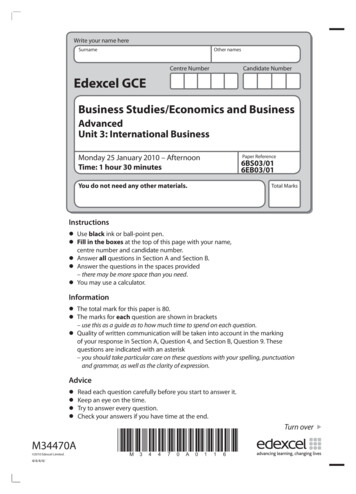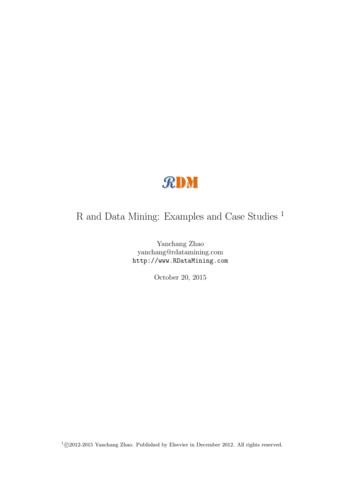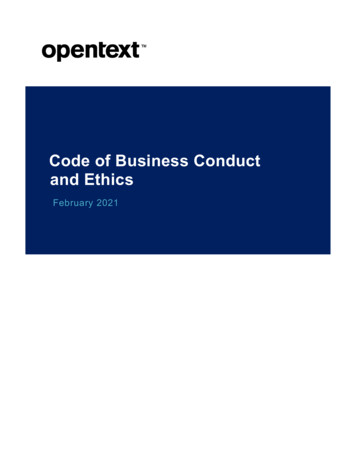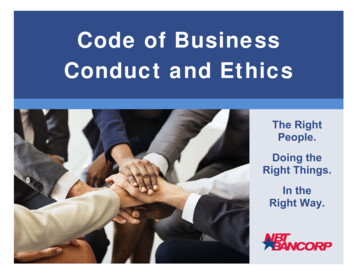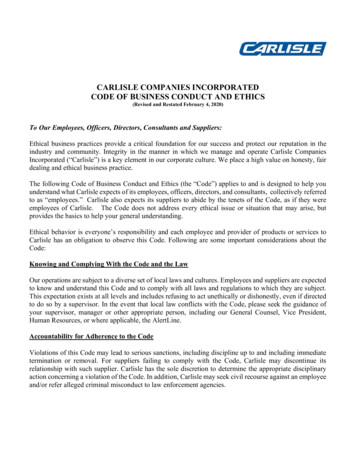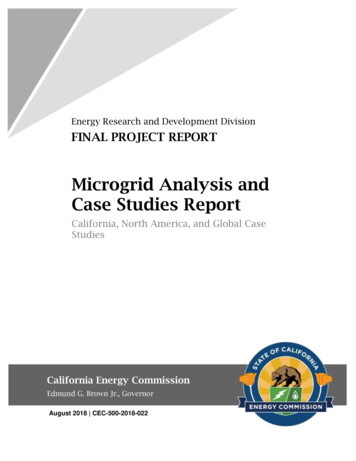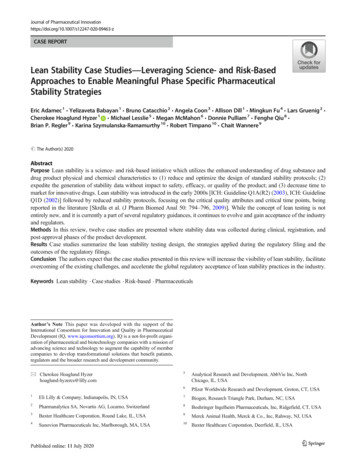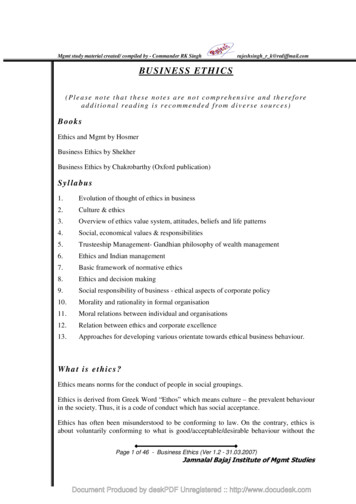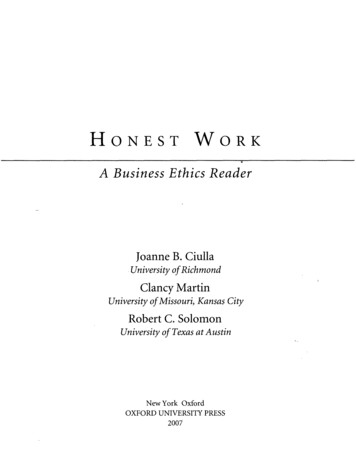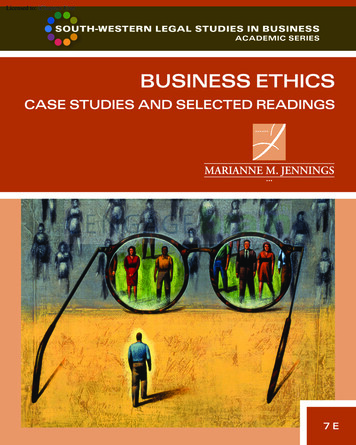
Transcription
Licensed to: iChapters User
Licensed to: iChapters UserBusiness Ethics: Case Studies andSelected Readings, Seventh EditionMarianne M. JenningsVice President of Editorial, Business:Jack W. CalhounEditor-in-Chief: Rob DeweyAcquisitions Editor: Vicky True-BakerSenior Developmental Editor:Laura Bofinger Ansara 2012, 2009 South-Western, Cengage LearningALL RIGHTS RESERVED. No part of this work covered by the copyrightherein may be reproduced, transmitted, stored, or used in any form orby any means graphic, electronic, or mechanical, including but notlimited to photocopying, recording, scanning, digitizing, taping, webdistribution, information networks, or information storage and retrievalsystems, except as permitted under Section 107 or 108 of the 1976United States Copyright Act, without the prior written permission ofthe publisher.For product information and technology assistance, contact us atCengage Learning Customer & Sales Support, 1-800-354-9706Editorial Assistant: Patrick Ian ClarkMarketing Manager: Laura-Aurora StopaFor permission to use material from this text or product,submit all requests online at www.cengage.com/permissionsSenior Content Project Manager:Colleen A. FarmerFurther permissions questions can be emailed topermissionrequest@cengage.comMedia Editor: Kristen MeereSenior Frontlist Buyer, Manufacturing:Kevin KluckSenior Marketing CommunicationsManager: Sarah GreberProduction Service: MPS Limited,a Macmillan CompanySenior Art Director: Michelle KunklerInternal Designer:Juli Cook/Plan-It-Publishing, Inc.Cover Designer: Tin Box StudiosCover Image: Curtis Parker/StockIllustration Source/Getty Images, Inc.Library of Congress Control Number: 2010938756ISBN-13: 978-0-538-47353-8ISBN-10: 0-538-47353-3South-Western Cengage Learning5191 Natorp BoulevardMason, OH 45040USACengage Learning products are represented in Canada by NelsonEducation, Ltd.For your course and learning solutions, visit www.cengage.comPurchase any of our products at your local college store or at ourpreferred online store www.cengagebrain.comPrinted in the United States of America1 2 3 4 5 6 7 14 13 12 11 10Copyright 2011 Cengage Learning. All Rights Reserved. May not be copied, scanned, or duplicated, in whole or in part. Due to electronic rights, some third party content may be suppressed from the eBook and/or eChapter(s).Editorial review has deemed that any suppressed content does not materially affect the overall learning experience. Cengage Learning reserves the right to remove additional content at any time if subsequent rights restrictions require it.
Licensed to: iChapters UserEthical Theory, PhilosophicalFoundations, Our Reasoning Flaws,and Types of Ethical DilemmasU N I T“In the 21st centurywill occur somethingworse than the greatwars, namely, the totaleclipse of all values.The pain the humanbeast will feel when herealizes he can believein . . . nothing . . . willbe worse than any hehas felt before.”O N EBefore we begin the study of business ethics, we should do some introspection:what does ethics mean to me personally? The purpose of this unit is to provideyou with an introspective look at you and your views on ethics before we bringthe business component to you and ethics.This unit explains three things: what ethics are, why we should care about ethics, andhow to resolve ethical dilemmas. The materials in this unit serve as the foundation forthe study of issues in business ethics. We begin with a personal look at ethics, discusswhy it matters, and then decide how to resolve ethical dilemmas.—Nietzsche“I was very upset thatthere’s that manydishonest people.”—Andrea Reuland, theowner of Trigs ShellStation in Minocqua,Wisconsin, who lost 3.00 per gallon on586 gallons of gas soldduring a 45-minuteperiod when localresidents phoned othersto come and get gasbecause an employeehad made a mistake andentered the price at32.9 cents vs. 3.299per gallon. 87 percent ofpeople who respondedto a survey about theincident said they wouldhave done the samething as the Minocquaresidents.1Copyright 2011 Cengage Learning. All Rights Reserved. May not be copied, scanned, or duplicated, in whole or in part. Due to electronic rights, some third party content may be suppressed from the eBook and/or eChapter(s).Editorial review has deemed that any suppressed content does not materially affect the overall learning experience. Cengage Learning reserves the right to remove additional content at any time if subsequent rights restrictions require it.
Licensed to: iChapters UserCopyright 2011 Cengage Learning. All Rights Reserved. May not be copied, scanned, or duplicated, in whole or in part. Due to electronic rights, some third party content may be suppressed from the eBook and/or eChapter(s).Editorial review has deemed that any suppressed content does not materially affect the overall learning experience. Cengage Learning reserves the right to remove additional content at any time if subsequent rights restrictions require it.
Licensed to: iChapters UserDefining EthicsS EC T I O N1AReading 1.1You, Your Values, and a CredoWe have a tendency to look at folks who get into ethical and legal trouble and say, “I knowI would never behave like that.” You probably would not, but you are only seeing them attheir last step. You did not see the tiny steps that led to their eventual downfall. Study howand why they made the decisions they made. The idea is to try to avoid feeling superior tothose who have made mistakes; real learning comes with understanding the flaws in theiranalyses and reasoning processes as well as the types of pressures that caused them to dowhat they did. Your goal is to develop a process for analysis and reasoning, one that findsyou looking at ethical issues more deeply, instead of through the prism of emotions, desires,and pressures. You are not just studying ethics, you are studying business history. But, youare also studying you. Try to relate your vulnerabilities to theirs. Remember as you readthese cases that you are reading about bright, capable, and educated individuals who mademistakes. The mistakes often seem clear when you study them in hindsight. But their ethicalanalyses at the time they were making these decisions was flawed, whether through poorperspective, pressure, or sometimes, the stuff of Greek tragedies: hubris.One of the goals of this text is to help you avoid the traps and pitfalls that consumesome people in business. As you study the cases in this unit and the others that followtry not to be too hard on the human subjects. Learn from them and try to discover theflaws in their ethical analyses.One step that can give us greater clarity when we face ethical dilemmas is a credo. Acredo is different from a code of ethics and does not consist of the virtues that companies usually list in a code of ethics, such as: we are always honest; we follow the laws.The credo demands more because it sets the parameters for those virtues. A credo is virtue in action. A credo defines you and your ethical boundaries.You get your personal credo with introspection on two areas of questions:1. Who are you? Many people define themselves by the trappings of success, such as how muchmoney they have or make, the type of cars they drive, their clothes, and all things tangible and material. A credo grounds you and means that you need to find a way to describe yourself in terms orqualities that are part of you no matter what happens to you financially, professionally, or in yourcareer. For example, one good answer to “Who are you?” might be that you have a talent and ability for art or writing. Another may be that you are kind, showing those Solomon-like virtues inReading 1.1 to others around you. List those qualities you could have and keep regardless of allthe outer trappings.2. The second part of your credo consists of answering this question: What are the things that youwould never do to get a job? To keep a job? To earn a bonus? The answer to this question resultsin a list, one that you should be keeping as you read the cases and study theindividual businesspeople who made mistakes. Perhaps the title of your list could be “Things IWould Never Do to Be Successful,” “Things I Would Never Do to Be Promoted,” or even “Things3Copyright 2011 Cengage Learning. All Rights Reserved. May not be copied, scanned, or duplicated, in whole or in part. Due to electronic rights, some third party content may be suppressed from the eBook and/or eChapter(s).Editorial review has deemed that any suppressed content does not materially affect the overall learning experience. Cengage Learning reserves the right to remove additional content at any time if subsequent rights restrictions require it.
Licensed to: iChapters User4 Unit 1: Ethical Theory, Philosophical Foundations, Our Reasoning Flaws, and Types of Ethical DilemmasI Would Never Do to Make Money.” One scientist reflected on the most important line that hewould never cross, and after you have studied a few of the product liability cases you will come tounderstand why this boundary was important to him, “I would never change the results of a studyto get funding or promise anyone favorable results in exchange for funding.” A worker at a refinerywrote this as his credo, “I would never compromise safety to stay on schedule or get my bonus.”An auditor in a state auditor general’s office wrote, “I would never sign a document that I knowcontains false information.” The credo is a detailed list, gleaned from reading about the experiencesof others, that puts the meat on Polonius’s immortal advice to his son, Laertes, in Shakespeare’sHamlet, “To thine own self be true” (Hamlet, Act I, Scene III). We quote Polonius without reallyasking, “What does that mean?” The credo takes us from eloquent advice to daily action. The credois a personal application of the lessons in the cases. You will spot the lack of definitive lines in thesecase studies and begin to understand how their decision processes were so shortsighted. The goal isto help you think more carefully, more deeply, and more fully about ethical issues.As you think about your credo, especially who you are, keep the following thought fromJimmy Dunne III in mind. Mr. Dunne was the only partner who survived the near destruction of his financial firm, Sandler O’Neill, when the World Trade Center collapsed on September 11, 2001. Only 17 of Sandler O’Neill’s 83 employees survived the tower’s collapse.Mr. Dunne has been tireless in raising money for the families of the employees who losttheir lives that day. When asked by Forbes magazine why he works so hard, Mr. Dunne responded, “Fifteen years from now, my son will meet the son or daughter of one of our people who died that day, and I will be judged on what that kid tells my son about what SandlerO’Neill did for his family.” His personal credo focuses on both the long-term reputation ofhis firm and the impact his choices can have on his children’s reputations.Discussion QuestionExplain the role “How do I want to be remembered?” plays in your credo?Reading 1.2 The Parable of the SadhuPressure, Small Windows of Opportunity, and Temptation1Bowen H. McCoy[In 1982], as the first participant in the new six-month sabbatical program that MorganStanley has adopted, I enjoyed a rare opportunity to collect my thoughts as well as dosome traveling. I spent the first three months in Nepal, walking 600 miles through 200villages in the Himalayas and climbing some 120,000 vertical feet. On the trip my soleWestern companion was an anthropologist who shed light on the cultural patterns ofthe villages we passed through.During the Nepal hike, something occurred that has had a powerful impact on mythinking about corporate ethics. Although some might argue that the experience has norelevance to business, it was a situation in which a basic ethical dilemma suddenly intruded into the lives of a group of individuals. How the group responded I think holdsa lesson for all organizations no matter how defined.The SadhuThe Nepal experience was more rugged and adventuresome than I had anticipated. Mostcommercial treks last two or three weeks and cover a quarter of the distance we traveled.Reprinted by permission of Harvard Business Review. From “The Parable of the Sadhu,” by Bowen H. McCoy,Harvard Business Review 61 (September/October 1983), 103–108. Copyright 1983 by the Harvard BusinessSchool Publishing Corporation; all rights reserved.1Copyright 2011 Cengage Learning. All Rights Reserved. May not be copied, scanned, or duplicated, in whole or in part. Due to electronic rights, some third party content may be suppressed from the eBook and/or eChapter(s).Editorial review has deemed that any suppressed content does not materially affect the overall learning experience. Cengage Learning reserves the right to remove additional content at any time if subsequent rights restrictions require it.
Licensed to: iChapters UserSection A: Defining Ethics 5My friend Stephen, the anthropologist, and I were halfway through the 60-day Himalayan part of the trip when we reached the high point, an 18,000-foot pass over a crestthat we’d have to traverse to reach the village of Muklinath [sic], an ancient holy placefor pilgrims.Six years earlier I had suffered pulmonary edema, an acute form of altitude sickness, at16,500 feet in the vicinity of Everest base camp, so we were understandably concernedabout what would happen at 18,000 feet. Moreover, the Himalayas were having their wettestspring in 20 years; hip-deep powder and ice had already driven us off one ridge. If we failedto cross the pass, I feared that the last half of our “once in a lifetime” trip would be ruined.The night before we would try the pass, we camped at a hut at 14,500 feet. In thephotos taken at that camp, my face appears wan. The last village we’d passed throughwas a sturdy two-day walk below us, and I was tired.During the late afternoon, four backpackers from New Zealand joined us, and we s
Reading 1.2 The Parable of the Sadhu Pressure, Small Windows of Opportunity, and Temptation1 Bowen H. McCoy [In 1982], as the first participant in the new six-month sabbatical program that Morgan Stanley has adopted, I enjoyed a rare opportunity to collect my thoughts as well as do some traveling. I spent the first three months in Nepal, walking 600 miles through 200 villages in the Himalayas .


